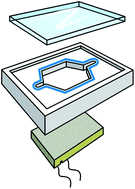Acoustofluidics 9: Modelling and applications of planar resonant devices for acoustic particle manipulation
Abstract
This article introduces the design, construction and applications of planar resonant devices for particle and cell manipulation. These systems rely on the pistonic action of a piezoelectric layer to generate a one dimensional axial variation in acoustic pressure through a system of acoustically tuned layers. The resulting acoustic standing wave is dominated by planar variations in pressure causing particles to migrate to planar pressure nodes (or antinodes depending on particle and fluid properties). The consequences of lateral variations in the fields are discussed, and rules for designing resonators with high energy density within the appropriate layer for a given drive voltage presented.

- This article is part of the themed collection: Acoustofluidics

 Please wait while we load your content...
Please wait while we load your content...